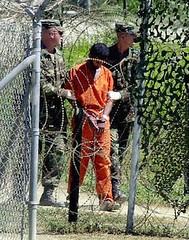
US Held Inmates at Guantanamo Naval Base in Cuba
Originally uploaded by Pan-African News Wire Photo File
Action Alert
NYT's Pentagon Propaganda: Misleading report on Guantánamo and terrorism
5/27/09
While former Vice President Dick Cheney has been front and center in the media debate over the current White House's national security policies, he's not the only one trying to challenge the White House's message. The New York Times published a front-page article (5/21/09) that bolstered the notion that former Guantánamo prisoners "return" to terrorist activity.
The remarkably credulous Times story, under the headline "1 in 7 Freed Detainees Rejoins Fight, Report Finds," was based on a Pentagon report leaked to the paper before its release yesterday evening. The article emphasized the notion that former prisoners "returned to terrorism or militant activity"--without adequately explaining the definition of either term, or examining whether those former detainees were ever "terrorists" in the first place. And as Talking Points Memo has noted (5/26/09), the Times' front-page headline claiming that "1 in 7" detainees had returned to the fight glossed over the DOD's own distinction between "confirmed" and "suspected" cases.
And missing from Times reporter Elisabeth Bumiller's account was a full explanation of the Pentagon's long history of releasing similar studies, which have been widely challenged and debunked. Attorney H. Candace Gorman, who represents some Guantánamo detainees, has challenged the Pentagon's findings (Huffington Post, 3/13/07), as has journalist and terrorism analyst Peter Bergen (CNN, 1/24/09). As one prominent critic, Mark Denbeaux of Seton Hall, explained (Washington Independent, 1/23/09):
Every time they have been required to identify the parties, the DOD has been forced to retract their false IDs and their numbers. They have included people who have never even set foot in Guantánamo--much less were they released from there. They have counted people as "returning to the fight" for their having written an op-ed piece in the New York Times and for their having appeared in a documentary exhibited at the Cannes Film Festival. The DOD has revised and retracted their internally conflicting definitions, criteria, and their numbers so often that they have ceased to have any meaning--except as an effort to sway public opinion by painting a false portrait of the supposed dangers of these men.
The Times quoted Denbeaux deep in its May 21 piece, but those comments failed to convey the serious problems with the Pentagon's previous reports on Guantánamo.
More fundamentally, can the Times be sure that the Pentagon knows that the detainees were ever "terrorists" to begin with? As Denbeaux explained in one report (12/10/07 [PDF]), "Implicit in the Government's claim that detainees have 'returned to the battlefield' is the notion that those detainees had been on a battlefield prior to their detention in Guantánamo." He concluded, based on reviewing the Pentagon's own Combatant Status Review Tribunal records, that just 4 percent of the available summaries "alleged that a detainee had ever been on any battlefield." Only one detainee was actually captured by U.S. forces on a battlefield. And, of course, fighting U.S. forces on a battlefield is not in itself an act of "terrorism."
Even Bumiller seemed to distance herself from some of the language in her piece. Appearing on MSNBC (5/21/09), she noted that "there is some debate about whether you should say 'returned' because some of them were perhaps not engaged in terrorism, as we know--some of them are being held there on vague charges." The Times went on to make significant changes to the report on its website (TPM Muckraker, 5/21/09). The new headline is "Later Terror Link Cited for 1 in 7 Freed Detainees," and the piece reported that the former detainees "are engaged in terrorism or militant activity"--as opposed to "returned to terrorism or militant activity."
Times Washington bureau chief Dean Baquet (Politico, 5/21/09) responded by arguing that the changes were not all that significant:
The story was about the estimate of the number of people who ended up, by DOD's account, as being engaged in terrorism or militant activity after leaving Gitmo. That still stands. The change was an acknowledgment that some assert that not everyone in Gitmo is truly a terrorist. Some critics have said that Gitmo is also filled with people who aren't truly terrorists.
This is disingenuous, at the very least. The story was about people "returning" to the "fight," based on the latest in a series of misleading and contradictory Pentagon reports on the topic--which should have led the Times to treat the leak with more skepticism in the first place. The paper noted in the article that the report's "conclusion could strengthen the arguments of critics who have warned against the transfer or release of any more detainees as part of President Obama's plan to shut down the prison by January." That is precisely the effect it had (conservative MSNBC host Joe Scarborough gave the paper a "tip of the hat"--5/21/09), thanks entirely to the way the Times mishandled the story.
ACTION:
Ask New York Times public editor Clark Hoyt to examine the way the Times handled its May 21 story about the Pentagon's claims regarding Guantánamo detainees. Did the paper's original report do enough to challenge the Pentagon's claims? And do the paper's subsequent changes to the story warrant some explanation to readers?
CONTACT:
Clark Hoyt
Public Editor, New York Times
212-556-7652
public@nytimes.com
No comments:
Post a Comment